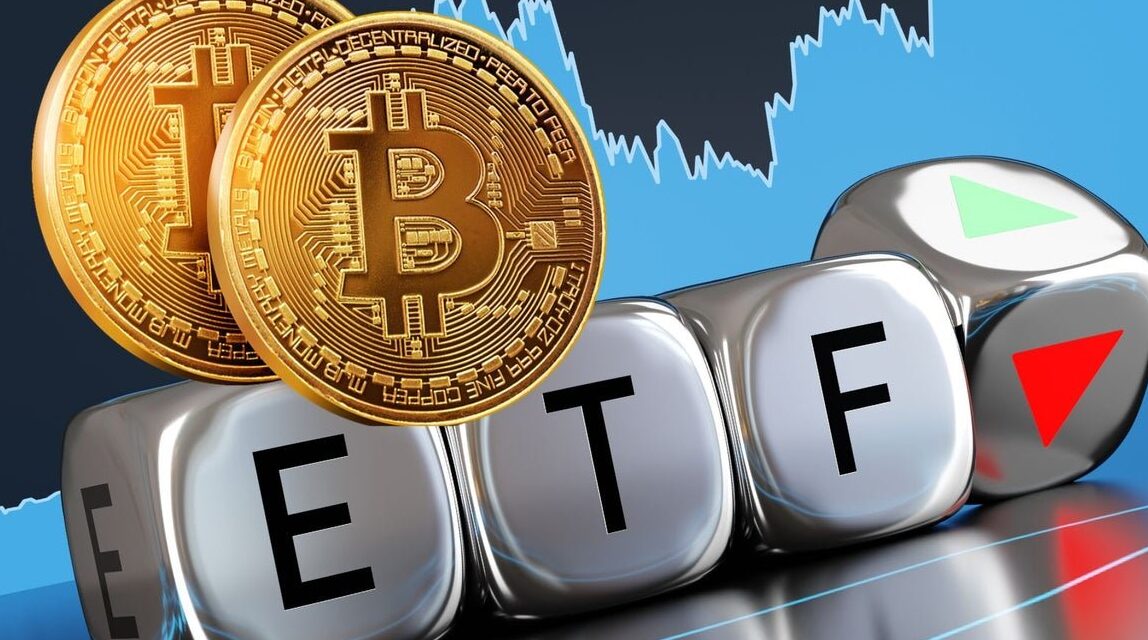The cryptocurrency market is quite stable right now, as both Bitcoin (BTC) and (ETH) continue to rise. BTC is bouncing around important resistance levels above $71,000, and ETH is strong over $3,700. This makes it seem like the digital asset industry is ready for a longer bullish phase. This strength comes at a time when institutional investors are putting a lot of money into spot exchange-traded funds (ETFs) and the US and China are talking about their differences again, which could affect the overall mood of the economy. These elements that are connected to each other point to a deep and complex base for the current growth in major cryptocurrencies.
Spot ETFs Boost Crypto Adoption
One of the main reasons why Crypto market ETFs Bitcoin Ethereum prices have been going up lately is that spot ETFs are becoming more popular in the US. The U.S. Securities and Exchange Commission (SEC) approved these investment vehicles, which have made it easier for traditional institutional capital to flow into Crypto Market without the problems that come with holding digital assets.
 BlackRock’s iShares Crypto market ETFs Bitcoin Ethereum Trust (IBIT), Fidelity’s Wise Origin Bitcoin Trust (FBTC), and other comparable funds have all had steady inflows, bringing their total assets under management (AUM) to billions. These ETFs are more than just financial tools; they are a big step toward becoming widely used. The story of the spot Bitcoin ETF is quite similar to the idea of “safe haven diversification,” especially since traditional markets are having trouble with volatility caused by uncertainties about interest rate policy and declining global growth. The constant inflows into spot ETFs show that more and more investors want to own BTC and ETH as long-term stores of value and protection against the devaluation of fiat currency.
BlackRock’s iShares Crypto market ETFs Bitcoin Ethereum Trust (IBIT), Fidelity’s Wise Origin Bitcoin Trust (FBTC), and other comparable funds have all had steady inflows, bringing their total assets under management (AUM) to billions. These ETFs are more than just financial tools; they are a big step toward becoming widely used. The story of the spot Bitcoin ETF is quite similar to the idea of “safe haven diversification,” especially since traditional markets are having trouble with volatility caused by uncertainties about interest rate policy and declining global growth. The constant inflows into spot ETFs show that more and more investors want to own BTC and ETH as long-term stores of value and protection against the devaluation of fiat currency.
Ethereum ETFs Signal Institutional Shift
Crypto market ETFs Bitcoin Ethereum has been the leader in institutional investment through spot ETFs, but Ethereum is swiftly catching up. The SEC’s recent change of heart about an Ethereum ETF has made people in the digital asset industry feel hopeful. Grayscale, VanEck, and Invesco, among others, have all submitted proposals for spot ETH ETFs. If these proposals are approved, it might be a turning point for Ethereum’s market position.
The expected launch of Ethereum ETFs would not only make the market more liquid, but it would also provide more people access to ETH’s growing ecosystem, which includes decentralised financing (DeFi), non-fungible tokens (NFTs), and layer-2 scaling solutions like Arbitrum and Optimism. Additionally, Ethereum’s deflationary tokenomics, which are based on its EIP-1559 burn mechanism, provide it even more potential for long-term value growth, making it more appealing to institutional investors.
US-China Talks Lift Crypto Sentiment
In addition to crypto-native advancements, the larger macroeconomic environment is also helping to boost market sentiment. Ongoing talks between the US and China about trade have brought back a sense of hope to global risk markets, including cryptocurrencies. After conversations at the highest levels in Beijing and Washington, both countries have said they are willing to reset trade relations and start talking again about significant concerns like technology transfer, intellectual property, and supply chain security.
These trade talks will have a big effect on the global economy and, by extension, the digital asset market. Better cooperation between the two countries might make the market less unclear, bring in more money for new technologies, and lessen the burden on supply chains that are causing inflation. These kinds of events are pretty important for cryptocurrencies since they often affect how investors act and where they put their money.
Crypto Mimics Tech Amid Liquidity
Crypto market ETFs Bitcoin Ethereum have been acting more and more like tech-heavy indexes like the NASDAQ 100. This connection shows that people see crypto as a new technology investment. Like investing in the early days of the internet or AI. As central banks around the world become more accommodating or hint at pauses in raising interest rates, liquidity conditions get better. This makes people more willing to take risks across all asset classes.
The Federal Reserve’s recent remarks have been dovish, and inflation data suggests that a policy change may be coming. This has given both individual and institutional investors the confidence to put more money into high-beta assets. In this situation, crypto continues to do well as a market that is sensitive to liquidity. During times of global monetary expansion, money often flows into BTC and ETH.
On-Chain Metrics Support Bullish Trend
On-chain data backs up the positive mood even further. Bitcoin’s hash rate is still close to all-time highs. This shows that miners are still confident even after the recent halving event. Ethereum. On the other hand. Keeps up a lot of network activity. With daily active addresses and total value locked (TVL) in DeFi protocols staying strong.
 Also, Glassnode and IntoTheBlock statistics show that long-term holders and whales are buying more. These groups usually show the direction of the market. And their actions signal that prices will keep going up. The MVRV ratio and realised cap numbers for both BTC and ETH back up the idea that the market is healthy and growing. But not too hot yet.
Also, Glassnode and IntoTheBlock statistics show that long-term holders and whales are buying more. These groups usually show the direction of the market. And their actions signal that prices will keep going up. The MVRV ratio and realised cap numbers for both BTC and ETH back up the idea that the market is healthy and growing. But not too hot yet.
Final thoughts
Changes in regulations are also helping to stabilise the crypto markets. The Biden administration has said that they are open to more straightforward rules and regulations in the United States. The House just enacted the Financial Innovation and Technology for the 21st Century Act (FIT21). Its goal is to make clear what the SEC and the Commodity Futures Trading Commission (CFTC) are supposed to do when it comes to digital assets.
The Markets in Crypto-Assets (MiCA) rule is getting closer to being fully implemented in Europe. It will give crypto firms a complete legal framework. These frameworks not only make it easier for institutions to get involved by making sure they follow the rules. Keep things safe. And safeguard investors as rules become clearer. Market trust improves, which makes it easier for money to flow into BTC and ETH.










